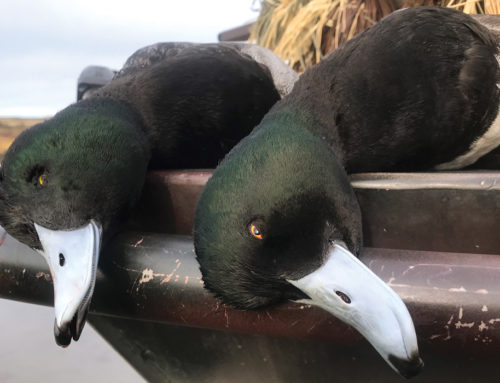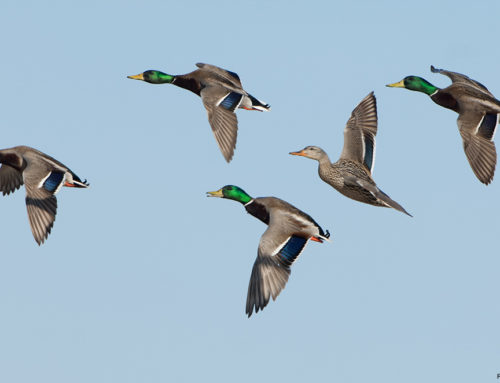The Flooded Timber of … Saskatchewan?

By Ken Bailey
If I were to tell you that my most memorable hunts last fall included a fabulous flooded timber mallard shoot and a gorgeous full-plume wood duck drake brought to hand, you’d probably guess that I’d hunted Arkansas, or perhaps Mississippi. You couldn’t be more wrong — I actually hunted the prairies of southern Saskatchewan, where a flooded timber hunt and a drake woodie winging into our field decoys one morning were just two of the surprises I enjoyed.
 I’d been invited to join Dennis Brune and Doug Eckelkamp of ALPS OutdoorZ at the renowned Habitat Flats camp outside of Yorkton, Saskatchewan. I’ve hunted from this camp in the past, and had a pretty good idea of what to expect: fantastic shoots for Canada geese, cranes and mallards.
I’d been invited to join Dennis Brune and Doug Eckelkamp of ALPS OutdoorZ at the renowned Habitat Flats camp outside of Yorkton, Saskatchewan. I’ve hunted from this camp in the past, and had a pretty good idea of what to expect: fantastic shoots for Canada geese, cranes and mallards.
Opening morning went as anticipated, though a Saskatchewan hunting experience is inspiring even when it goes as expected. It was perfect waterfowler’s weather, overcast with a light wind. A steady breeze always helps to keep the birds on track. Our target that morning was sandhill cranes, prehistoric-looking birds whose unusual characteristics are at odds with their succulent meat, which is highly underrated by many. In fact, given the choice, I’d sooner dine on cranes than Canada geese.
We placed three-dozen full-body sandhill decoys, a small setup when compared to typical goose spreads, but more than enough to fool cranes. An hour and a half later, we were picking up, loading 17 cranes into the trucks alongside the decoys. With four shooters, we were three birds short of our limit, but that was more a reflection on our shooting prowess than on the opportunities presented. All in all, it was a pretty typical morning of southern Saskatchewan waterfowling. It was that afternoon when things took a turn toward the unusual.
To the Timber
As is the norm in prairie Canada after a morning crane or goose hunt, ducks were on the afternoon menu. Generally, that means hunting the stubble out of blinds while sitting over several dozen or even hundreds of decoys, so you can imagine our astonishment when we set up for a flooded timber hunt. By set up, I mean the four of us leaned against towering poplars, standing watch over a half-dozen floaters and a spinning-wings decoy. Unusually heavy late summer rains had flooded the five-acre wetland well above the shoreline grasses, past the willows and even above the normally high-and-dry poplars. It was more reminiscent of a traditional Arkansas hunt than anything I’d experienced before in Saskatchewan, but if the birds were going to be there, all of us were keen to give it a go.
As it turns out, the ducks arrived in dribs and drabs. The shooting was a challenge given the difficulty in finding and swinging on settling birds amid the branches. Through determination we managed to drop a handful of mallards and a couple wigeon, but the highlight was a Canada goose that another hunter in our party pulled down as it cruised curiously over our spread. A Canada goose on a flooded timber hunt? I guess you haven’t seen it all until you’ve seen that.
Watching Cranes
We were far from having witnessed the last of the unusual, however, as the following morning’s crane hunt turned out to be a bust. On that clear and cold late-October morning, we hunkered in our blind for three hours, watching longingly as thousands of cranes punctured the western skyline, exactly as scripted. Yet instead of swinging north into our field as they had under the watchful eyes of our scouters the previous day, for reasons known only to the birds, they continued on a straight eastward path. We watched helplessly as flock after flock glided down a thousand yards to the south.
 When we finally called it a morning, we didn’t have a single bird for our efforts, a nearly-unheard-of result in these parts. It did serve to remind, however, that at the end of the day, no matter how much planning and effort you expend, there’s simply no accounting for the nuances that ultimately lead our quarry to do what they do. And that’s the way it should be, for only when events turn sideways do we fully appreciate those days when it unfolds perfectly.
When we finally called it a morning, we didn’t have a single bird for our efforts, a nearly-unheard-of result in these parts. It did serve to remind, however, that at the end of the day, no matter how much planning and effort you expend, there’s simply no accounting for the nuances that ultimately lead our quarry to do what they do. And that’s the way it should be, for only when events turn sideways do we fully appreciate those days when it unfolds perfectly.
The bright side of several hours in a blind with no shooting was that it provided me the opportunity to get to know Brune, Eckelkamp and ALPS OutdoorZ a little better. ALPS is largely a family-run business, I discovered, ensuring it is nimble enough to make quick, firm decisions and react to market opportunities that present themselves. The company’s commitment to wildlife habitat also is evident through partnerships with several non-profit conservation organizations, including Delta Waterfowl.
ALPS manufactures a wide range of well-designed, quality gear for waterfowlers, from its comfortable, portable and effective Delta Waterfowl Gear Zero-Gravity Layout Blinds to packs, field bags, slings, gun cases, dog accessories and more. I had the opportunity to use ALPS products in the field, and came away very impressed. All of the ALPS products are no-nonsense, practical gear that would clearly withstand the rigors of everyday use.
Colorful Surprise
Our final morning’s hunt proved to be more typical of southern Saskatchewan — with one notable exception.
We set up in a rolling barley stubble field, and the mallards arrived on cue in a succession of small flocks that made for great gunning. It was one of those hunts where early success allows everybody to relax and fully enjoy the experience. All of us had plenty of shooting opportunities. As the minutes passed, the ducks in hand piled up. The hunt was unfolding exactly as it was drawn up — until an unusually colored bird buzzed through our decoys amid a flock of drake mallards, that is.
 Whenever an unexpected bird appears, whether it’s sporting a collar, or is an unusual color or species, every hunter immediately fixates on it — irrespective of whether it’s in his or her shooting lane. I’m not really sure who tumbled it (I like to think it was me), but at the report of our shotguns, the drake wood duck hit the stubble. Now wood ducks are not completely unheard of in Saskatchewan, but they’re rare enough that our guide advised it was the first he’d seen on a hunt in this area. And to top it off, it wasn’t just any wood duck, but a fully plumed drake, about as pretty a bird as flies our skies.
Whenever an unexpected bird appears, whether it’s sporting a collar, or is an unusual color or species, every hunter immediately fixates on it — irrespective of whether it’s in his or her shooting lane. I’m not really sure who tumbled it (I like to think it was me), but at the report of our shotguns, the drake wood duck hit the stubble. Now wood ducks are not completely unheard of in Saskatchewan, but they’re rare enough that our guide advised it was the first he’d seen on a hunt in this area. And to top it off, it wasn’t just any wood duck, but a fully plumed drake, about as pretty a bird as flies our skies.
The woodie was a fitting end to our hunt. As I hit the highway for the long drive home, I reflected on our three days together: Odd hunts, an unusual species, and an opportunity to meet people who represent the very best of the hunting and conservation communities.
I had hunted Saskatchewan many times, but last fall, the province was full of surprising — and wonderful — revelations.
Ken Bailey is a freelance outdoor writer from Edmonton, Alberta.






As the owner and lead guide for 18 years with my Saskatchewan Waterfowl Outfitting business, the diversity and sheer number of migrating waterfowl in the Saskatchewan Central Flyway area near the South Saskatchewan River, where I live & work, constantly amazes me. The bounty of nature here is a sight to see. Many states in the U.S. are restricted from hunting Sand Hill Cranes, which is one the unique and fun hunts guys can have the pleasure of experiencing in Saskatchewan. Yes, I second your opinion on Crane – mighty tasty – nothing beats “rib eye of the sky” on the BBQ!
Cory, Owner Highland Outfitters, Saskatchewan.
I Hunted sand hill cranes with quill lake waterfowl outfitters this past September and it was a blast. I’m already looking for a place to do it in the USA this season. The noises they make and the way they fly is an experience every waterfowler should have. I’d also highly recommend quill lake waterfowl outfitters for cranes. I wasn’t planning on hunting them when I went up to Saskatchewan, but when the opportunity presented itself I’m glad I took it. Great article and totally agree-never know what you’re gonna get in the land of the living skies.